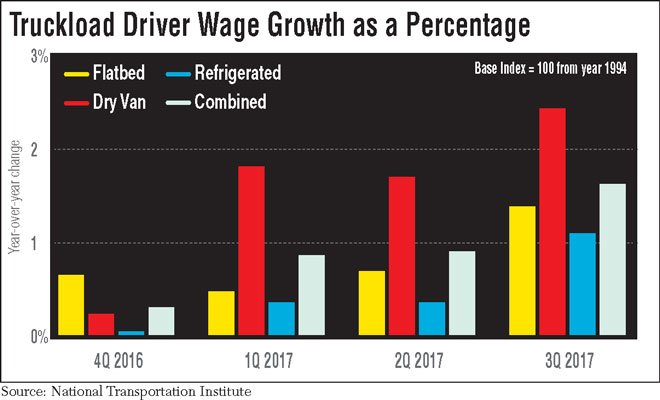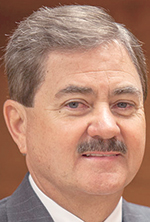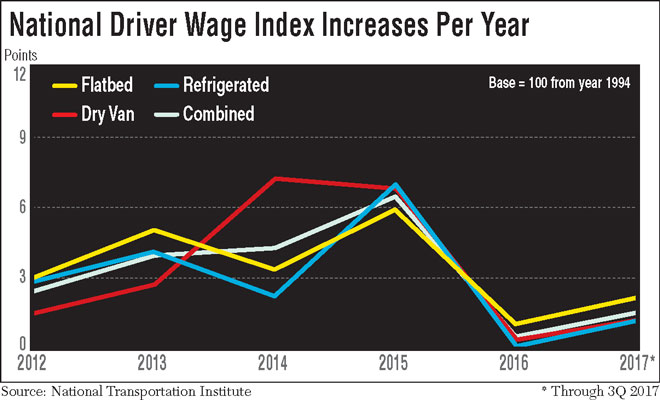Longhaul Driver Pay Jumps 1.6% in Third Quarter

Longhaul truck driver pay rose in the third quarter as the truckload market tightened over the summer, setting the stage for a lift in salaries in 2018, according to the National Transportation Institute.
The National Driver Wage Index rose 1.6% year-over-year to 156.26, the strongest growth rate since the first quarter of 2016. The dry van index jumped nearly 2.5% to 152.54, flatbed rose 1.4% to 159.29 and refrigerated increased 1.1% to 156.95.
Last year, the combined index rose just 0.3% compared with 2015. The institute uses a base of 100 to represent conditions in 1994.

Klemp
“We expect these trends to continue into the fourth quarter. We are at the edge of the cliff that has been talked about for some time but never reached,” NTI CEO Gordon Klemp said on a conference call with Stifel, Nicolaus & Co.
He cited two factors fueling the freight market and competition to keep drivers happy.
One, gross domestic product grew at a 3% annualized rate in the third quarter. If estimates hold after additional revisions, it would be the first time the economy expanded at least 3% in consecutive quarters since mid-2014.
Two, the unemployment rate fell 0.1 percentage point to 4.1% in October, the lowest level since December 2000.
“If we can sustain a vibrant economy, we’ll probably go negative on capacity pretty quickly,” Klemp said. “I don’t see the driver pool changing any time soon, so I think it’ll be quite an adventuresome exchange on drivers and compensation and freight rates.”

In the third quarter, average truckload pay increased 1 cent to 2 cents per mile, minimally, and 4 cents to 7 cents in high-demand markets such as Chicago, Fort Wayne, Ind., and Allentown, Pa.
Carriers are offering sign-on and referral bonuses to lure drivers from their counterparts. Many sign-on bonuses range from $5,000 to $10,000, although Boyd Brothers Transportation, a Daseke Inc.-owned flatbed carrier, last month announced a $14,000 offer.
Bulldog Hiway Express and Hornady Transportation, two other Daseke fleets, introduced new pay scales. Bulldog guarantees a minimum of $1,000 a week in its flatbed division and emphasizes the “work-less earn-more” philosophy, according to CEO Phil Byrd. The plan sets a minimum of 50 cents per mile on an average of 2,000 total miles per week and $300 additional weekend pay after two consecutive weekends on the road.

Byrd
Hornady will increase salaries 4 cents per mile to drivers with at least three years experience. Drivers already with the company will get a 2 cents more. Hornady also offers a $2,500 sign-on bonus.
Refrigerated carrier W.N. Morehouse Truck Line also announced pay will increase between 42 and 49 cents per mile on Dec. 1.
Maverick USA Inc. boosted pay 5 cents per mile in the flatbed and glass over-the-road divisions on Dec. 18 and will offer a $5,000 sign-on bonus. Longhaul flatbed pay will range from 51 cents to 56 cents, regional flatbed 49 cents to 54 cents and glass division 55 cents to 60 cents.
“If we want freight to move as we are accustomed, driver pay is going to have to go up substantially,” Maverick USA President John Culp told Transport Topics.

Like other executives, Culp said he believes drivers aren’t paid enough. He cited Stephens Inc. and U.S. Bureau of Labor statistics that show the national average hourly wage grew 111% between 1990 and 2016 while truck driver pay increased 55% during the same period.
“Trucking still has a large gap to make up when you look at how driver pay has lagged in comparison to growth in other industries such as construction and manufacturing. For example, since 2006, for-hire driver pay, unadjusted for inflation, has risen just 6.3%. That’s an ugly number for the last 10 years,” Culp noted.
Maverick ranks No. 80 on the Transport Topics Top 100 list of the largest for-hire carriers in North America.
In August, dry van carrier Ozark Motor Lines boosted linehaul drivers’ pay to 41 cents to 46 cents per mile and regional drivers’ to 38 cents to 43 cents.
Ozark Vice President Jason Higginbotham said that once a few carriers raise pay, it causes a chain reaction among fleets.
“Turnover has definitely been strong, but we’ve made significant headway in filling trucks since the pay increase,” Higginbotham said. But he added, “I definitely feel like there will be a second round of pay increases sometime in 2018 as people continue to compete for drivers. Offers like Boyd Brothers’ $14,000 sign-on bonus show just how frothy certain industry segments already are.”
John Fritzius, chief operating officer at Motor Carrier Service, said he anticipates he’ll raise pay within the next year, but believes his turnover is below average because he prioritizes work-life balance with his drivers.
He said: “Imagine sitting at your desk for 10½ hours because you’re required to do so. When you’re done, you can go eat, but you have to do so back at your desk. Then, after you’re done, turn around, take a step back and lay down on your credenza and sleep for 10 hours. That’s a drivers life. That’s what I explain to shippers.”




